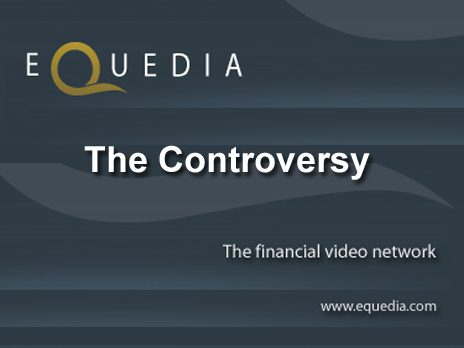*If you have not already subscribed to our weekly interactive newsletter, please visit: http://equedia.com/newsletter/
For the full interactive edition, please CLICK HERE
Usage: Feel free to post this article anywhere you’d like. Just be sure to follow the rules set forth in our usage agreement by CLICKING HERE
From another Canadian election to precious metals hitting an all time high, we’ve got lots to talk about this week.
Before we get started, the results from last week’s survey, “Do You Use Twitter?” are in. Here are the results:
- 80.8% of you do NOT use Twitter
- 19.1% of you Use Twitter, and would follow us
- 1.1% of you USE Twitter, but would not follow us
As such, I have decided to not move ahead with the Equedia Twitter account – for now. Some of the comments from the survey are listed below. For the many of you who wanted to follow us, thank you for the kind words left in the comments. Let’s move on.
Politics
As a Canadian, I am extremely fed up. Throughout the last few years during the recession, Canada has become one of the most prominent countries in the world. We now rank number one in the world for the best banking system and was the first nation to step out of the recession. We’ve increased our military defences (a must as a growing nation) and we have grown exponentially with the help of our natural resources.
You may not like Stephen Harper. You may think he’s a liar. You may think he has no charisma. But Canada has done well.
Do we really need another election?
For this week’s survey, I’d like to know what you think and who you’re going to vote for.
Cast Your Vote By CLICKING HERE
With this election, taxpayers are once again being forced to pay up. We spent $277 million for the 2004 election. In 2006, we spent $270 million. In 2008, we spent $325 million. That means Canadian taxpayers have unnecessarily spent $872 million in the last 7 years. After this election is over, we’re going to surpass the billion-dollar mark.
Four elections. Seven Years. One billion dollars. What a joke. And we call Canada a democracy.
Timing the Markets
Before last week got started, I went against the grain and called for an uptick in the markets (see The Controversy). It happened. The week before that, I called for a major pullback despite the markets climbing the day of the earthquake. It happened. During that pullback, I said I would be buying stocks such as Barrick Gold (TSX, NYSE: ABX) and Kiska Metals (TSX.V: KSK). While Kiska has remained flat, Barrick climbed as high as $51.49, up from just under $48 in a short week.
Minco Gold (TSX: MMM) (AMEX: MGH), a company we featured in January (see The Hidden Gold Producer) at a price of CDN$2.14 and US $2.16, hit a high of CDN$2.65 and US$2.71 this past week. I’ll be speaking with management again next week to check up on their progress.
Oil stocks are also up and I am looking for some of the bigger dividend players to step up and increase their dividends over the course of this year, which should lead to an increase in capital gains.
My market timing calls have been bang on. Even when most of the newsletter writers and technical traders said otherwise, I stuck to my beliefs. But my point is not to brag or gloat about these minor achievements. Timing the markets is something that we can all do with enough research – and luck. Sometimes I am wrong. And sometimes I am right.
The point I am trying to make is that perception is everything and you can’t always believe what you read.
The media is always late to the punch because it takes a lot more time than you think for a journalist or reporter to gather information on a story. It could take weeks before an article is published. If that article catches the attention of other media outlets, it could take those outlets another few weeks.
The media will tell a story for as long as someone is willing to listen. Once a story breaks out, every media outlet wants a piece to capture the audience. But once that audience gets bored, they move on. For the media, it’s about ratings – not the truth.
When you trade the markets, you have to understand this.
Real news happens immediately but it takes time for the media to catch on. As such, investors often take too much time to digest the information. By the time they’ve made a decision, Wall Street has already made money by either unloading their profits on an uptick, or picking up cheap shares from the panic selling of retail investors.
If you’re going to trade, you need to be proactive and react instantly on pullbacks or strong daily climbs resulting from market events. Big market swings often lead to big market gains or losses. For the majority of us, day trading isn’t an option. That’s why if you believe we’re in a bull market, you shouldn’t worry about the daily fluctuations of a stock.
“Disregarding the big swing and trying to jump in and out was fatal to me. Nobody can catch all the fluctuations. In a bull market the game is to buy and hold until you believe the bull market is near its end.” – Jesse Livermore
What to Expect
As I mentioned in the last newsletter (see The Controversy), the market should perform well over the course of this year led by the precious metals sector because, “people need to beat the rate of inflation just to survive. The US government will continue to add more money into the system which will help the stock market climb, but in its attempt it will cause prices to rise. This in turn will force investors to make riskier bets in the market to beat inflation, thus forcing the market higher.”
Stocks may appear to be a good hedge against inflation because, in theory, a company’s revenue and earnings should grow at the same rate as inflation over time. As corporations raise their prices, revenue will appear to grow but it is all artificial. So the stock market may be moving up, but that is all relative to capital erosion.
Last week, I also made a strong point that precious metals will continue to climb, with silver leading the way. Silver hit an all-time high on Thursday surpassing the $38/oz mark, climbing 5.8% on the week while gold added 0.7%.
While some of us have already grabbed the precious metals bull market by the horns, the majority of the overall market has yet to jump in. But that majority will soon begin their accumulation as the media continues to further the demise of the Dollar and the rise of a new gold standard. While a gold standard is unlikely, the idea of it will be more than enough to get the crowd going. Remember, perception is reality.
George Soros, one of the world’s top billionaire hedge fund managers, is holding a conference in the next few weeks to change how the global currency works by moving the US Dollar away as the world’s reserve currency. The media has garnered it little attention, despite Soros being one of the most influential men on this planet. Take a look at the video here:
George Soros’ Effort to Change How the Global Currency Works
I have said it before, and I’ll say it again. The precious metals run is far from over. Gold showed incredible support last week and the line of least resistance is now to the upside. Is it in a bubble? Yes. But the bubble isn’t about to pop anytime soon.
While I believe the precious metals sector will continue to climb, the overall stock market may not fare as well after this year.
A continued bull market is usually indicative of healthy earnings for corporations. Stocks in the S&P 500 are currently priced near 15 times earnings, offering shareholders a potential real return of 6.5 percent if corporations can maintain their earnings and price-to-earnings ratios do not drop in the future.
Over the next 5-10 years, if earnings continue to recover as they have during historical business cycles, stocks are likely to pay returns that compare favourably to their historical averages – all relative to inflation, of course.
At the end of the day, that means interest rates will eventually rise and curb the growth of the overall market.
We’re seeing healthy earnings right now because the cost of borrowing for corporations is at its all time lows. At some point, surging inflation – both direct, and from the rise in commodity and energy prices – will force the Fed to push up interest rates.
So while the stock market should rise with inflation over the next 5-10 years, the real rate of return won’t be good. Take advantage of this bull market while it lasts because after that we’re going to get pretty stagnant.
Housing Market
I believe US real estate, while not at its complete bottom, is starting to look like a good investment. Even with dismal housing numbers recently released, the prospects for long-term growth are in place.
Given a long term time frame investment of 5 years plus, slowly dabbling with smart investments in the sector now will return great rewards. The housing market will not bring the US back to economic equilibrium now, but prices should once again rise along with inflation.
The Canadian markets, on the other hand, has topped in my opinion and I expect a continued overall decline over the next 5 years as interest rates increase and over leveraged mortgage owners come under water with higher payments.
CMHC will tell you that we’re going to see growth this year and the next, but they are their own worst enemy. They’ll tell you the housing market is fine and dandy because they don’t want you to panic. As I have said before, there is conformity amongst fear in everything we do. If buyers panic, housing prices drop dramatically and we end up with have a major housing crisis.
While the CMHC has much stricter “internal” guidelines for its lending practices than Fannie Mae or Freddie Mac, Canada’s largest mortgage insurer has still pushed its limits by encouraging mortgages that are well beyond the means of a borrower – especially as interest rates rise in the coming years.
The CMHC is the only major financial institution in Canada not regulated by OSFI (Office of the Superintendent of Financial Institutions.) Furthermore, like any insurer, the more mortgages they back, the more money they make. There are just too many borrowers that have overleveraged themselves just to buy a dismal 750sq ft apartment for half a million dollars. Income growth is nowhere near the growth of property values, forcing new families and first time home buyers out of the market. This simply cannot go on.
While the CMHC says everything is okay, their actions are saying otherwise. As of last week, the maximum amortization period for a government-insured mortgage will be lowered from 35 to 30 years. The debt-to-income ratio of Canadian households have surpassed that of the U.S. for the first time in 12 years, climbing to over 146%.
Canada is now at the top of the 20 OECD nations in terms of debt-to-financial assets.
While Canada may not experience a catastrophic pullback like the US, a strong pullback is nonetheless inevitable. If you’re a Canadian, be careful. Interest rates will rise and housing prices will go down from here.
More Next Week
The Libyan rebels are advancing and it looks they are making good progress with the help of the world. If this continues, look for the markets to open up in green territory.
However, I would most certainly be cautious next week and slightly defensive as Gaddafi could seek to stage another Lockerbie-style attack in Britain in revenge for its role in the airstrikes.
The market is now in the hands of Libya and the Middle East.
Until next week,
Ivan Lo
Managing Director, Equedia Weekly
Equedia Network Corporation
www.equedia.com

Questions?
Call Us Toll Free: 1-888-EQUEDIA (378-3342)
We are biased towards Kiska Metals and Minco Gold because we own shares of both companies. We are also biased because they are a client of ours and we own options in both of the Companies. Our reputation is built upon on the companies we feature. That is why we invest in every company we feature in our Special Report Editions, including Kiska Metals and Minco Gold.
For the full interactive newsletter and report, please follow this link: http://archive.constantcontact.com/fs005/1102243211822/archive/1104877630006.html
If you have not already subscribed to Equedia Weekly, you may sign up here:http://equedia.com/newsletter/
Forward-Looking Statements
This Newsletter and report contains certain forward-looking statements that may involve a number of risks and uncertainties. Actual events or results could differ materially from current expectations and projections. Except for statements of historical fact relating to the project, certain information contained herein constitutes “forward-looking statements”. Forward-looking statements are frequently characterized by words such as “plan”, “expect”, “project”, “intend”, “believe”, “anticipate” and other similar words, or statements that certain events or conditions “may” or “will” occur.
Except for the statements of historical fact, the information contained herein is of a forward-looking nature. Such forward-looking information involves known and unknown risks, uncertainties and other factors which may cause the actual results, performance or achievement of the Company to be materially different from any future results, performance or achievements expressed or implied by statements containing forward-looking information.
Although the Company has attempted to identify important factors that could cause actual results to differ materially, there may be other factors that cause results not to be as anticipated, estimated or intended. There can be no assurance that statements containing forward looking information will prove to be accurate as actual results and future events could differ materially from those anticipated in such statements. Accordingly, readers should not place undue reliance on statements containing forward looking information. Readers should review the risk factors set out in the Company’s prospectus and the documents incorporated by reference.
Cautionary Note to U.S. Investors Concerning Estimates of Inferred Resources
This presentation uses the term “Inferred Resources”. U.S. investors are advised that while this term is recognized and required by Canadian regulations, the Securities and Exchange Commission does not recognize it. “Inferred Resources” have a great amount of uncertainty as to their existence, and great uncertainty as to their economic and legal feasibility. It cannot be assumed that all or any part of an Inferred Resource will ever be upgraded to a higher category. Under Canadian rules, estimates of “Inferred Resources” may not form the basis of feasibility or other economic studies. U.S. investors are also cautioned not to assume that all or any part of an “Inferred Mineral Resource” exists, or is economically or legally mineable.
Disclaimer and Disclosure
Disclaimer and Disclosure Equedia.com & Equedia Network Corporation bears no liability for losses and/or damages arising from the use of this newsletter or any third party content provided herein. Equedia.com is an online financial newsletter owned by Equedia Network Corporation. We are focused on researching small-cap and large-cap public companies. Our past performance does not guarantee future results. Information in this report has been obtained from sources considered to be reliable, but we do not guarantee that it is accurate or complete. This material is not an offer to sell or a solicitation of an offer to buy any securities or commodities.
Furthermore, to keep our reports and newsletters FREE, from time to time we may publish paid advertisements from third parties and sponsored companies. We are also compensated to perform research on specific companies and often act as consultants to many of the companies mentioned in this letter and on our website at equedia.com. We also make direct investments into many of these companies and own shares and/or options in them. Therefore, information should not be construed as unbiased. Each contract varies in duration, services performed and compensation received.
Equedia.com is not responsible for any claims made by any of the mentioned companies or third party content providers. You should independently investigate and fully understand all risks before investing. We are not a registered broker-dealer or financial advisor. Before investing in any securities, you should consult with your financial advisor and a registered broker-dealer. The information and data in this report were obtained from sources considered reliable. Their accuracy or completeness is not guaranteed and the giving of the same is not to be deemed as an offer or solicitation on our part with respect to the sale or purchase of any securities or commodities. Any decision to purchase or sell as a result of the opinions expressed in this report OR ON Equedia.com will be the full responsibility of the person authorizing such transaction.
Again, this process allows us to continue publishing high-quality investment ideas at no cost to you whatsoever. If you ever have any questions or concerns about our business or publications, we encourage you to contact us at the email or phone number below.
Please view our privacy policy and disclaimer to view our full disclosure at http://equedia.com/cms.php/terms. Our views and opinions regarding the companies within Equedia.com are our own views and are based on information that we have received, which we assumed to be reliable. We do not guarantee that any of the companies will perform as we expect, and any comparisons we have made to other companies may not be valid or come into effect. Equedia.com is paid editorial fees for its writing and the dissemination of material and the companies featured do not have to meet any specific financial criteria. The companies represented by Equedia.com are typically development-stage companies that pose a much higher risk to investors. When investing in speculative stocks of this nature, it is possible to lose your entire investment over time. Statements included in this newsletter may contain forward looking statements, including the Company’s intentions, forecasts, plans or other matters that haven’t yet occurred. Such statements involve a number of risks and uncertainties. Further information on potential factors that may affect, delay or prevent such forward looking statements from coming to fruition can be found in their specific Financial reports. Equedia Network Corporation., owner of Equedia.com has been paid $45,000 plus hst for a 19-month consulting agreement and 7 months of media coverage on Kiska Metals Corporation and has been granted 100,000 options at $1.35 vesting over a two year period. Kiska Metals has paid for this service. Equedia.com currently owns shares of Kiska Metals Corporation and we may purchase more shares without notice. We intend to sell every share we own for our own profit. We may sell shares in Kiska Metals Corporation without notice to our subscribers. Equedia Network Corporation., owner of Equedia.com has been paid six thousand three hundred and thirty three Canadian dollars plus gst/hst per month for 6 months which totals thirty eight thousand dollars plus hst of media coverage on Minco Gold Corporation plus 60,000 options. Minco Gold Corporation has paid for this service. Equedia.com currently owns shares of Minco Gold Corporation and we may purchase more shares without notice. We intend to sell every share we own for our own profit. We may sell shares in Minco Gold Corporation without notice to our subscribers.
Equedia Network Corporation is also a distributor (and not a publisher) of content supplied by third parties and Subscribers. Accordingly, Equedia Network Corporation has no more editorial control over such content than does a public library, bookstore, or newsstand. Any opinions, advice, statements, services, offers, or other information or content expressed or made available by third parties, including information providers, Subscribers or any other user of the Equedia Network Corporation Network of Sites, are those of the respective author(s) or distributor(s) and not of Equedia Network Corporation. Neither Equedia Network Corporation nor any third-party provider of information guarantees the accuracy, completeness, or usefulness of any content, nor its merchantability or fitness for any particular purpose.












